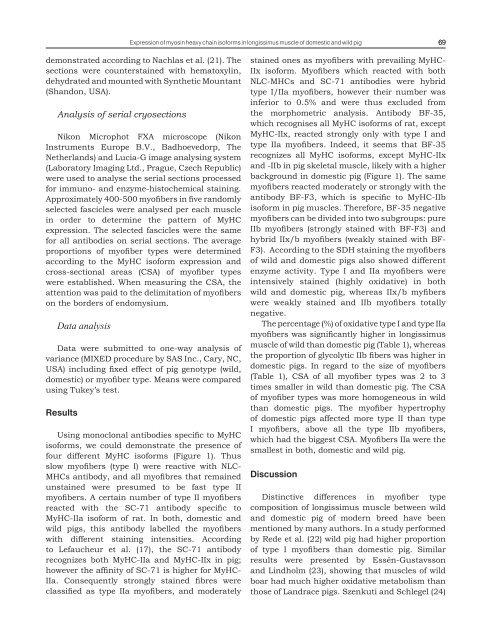SLOVENIAN VETERINARY RESEARCH
SLOVENIAN VETERINARY RESEARCH
SLOVENIAN VETERINARY RESEARCH
- No tags were found...
You also want an ePaper? Increase the reach of your titles
YUMPU automatically turns print PDFs into web optimized ePapers that Google loves.
Expression of myosin heavy chain isoforms in longissimus muscle of domestic and wild pig 69demonstrated according to Nachlas et al. (21). Thesections were counterstained with hematoxylin,dehydrated and mounted with Synthetic Mountant(Shandon, USA).Analysis of serial cryosectionsNikon Microphot FXA microscope (NikonInstruments Europe B.V., Badhoevedorp, TheNetherlands) and Lucia-G image analysing system(Laboratory Imaging Ltd., Prague, Czech Republic)were used to analyse the serial sections processedfor immuno- and enzyme-histochemical staining.Approximately 400-500 myofibers in five randomlyselected fascicles were analysed per each musclein order to determine the pattern of MyHCexpression. The selected fascicles were the samefor all antibodies on serial sections. The averageproportions of myofiber types were determinedaccording to the MyHC isoform expression andcross-sectional areas (CSA) of myofiber typeswere established. When measuring the CSA, theattention was paid to the delimitation of myofiberson the borders of endomysium.Data analysisData were submitted to one-way analysis ofvariance (MIXED procedure by SAS Inc., Cary, NC,USA) including fixed effect of pig genotype (wild,domestic) or myofiber type. Means were comparedusing Tukey’s test.ResultsUsing monoclonal antibodies specific to MyHCisoforms, we could demonstrate the presence offour different MyHC isoforms (Figure 1). Thusslow myofibers (type I) were reactive with NLC-MHCs antibody, and all myofibres that remainedunstained were presumed to be fast type IImyofibers. A certain number of type II myofibersreacted with the SC-71 antibody specific toMyHC-IIa isoform of rat. In both, domestic andwild pigs, this antibody labelled the myofiberswith different staining intensities. Accordingto Lefaucheur et al. (17), the SC-71 antibodyrecognizes both MyHC-IIa and MyHC-IIx in pig;however the affinity of SC-71 is higher for MyHC-IIa. Consequently strongly stained fibres wereclassified as type IIa myofibers, and moderatelystained ones as myofibers with prevailing MyHC-IIx isoform. Myofibers which reacted with bothNLC-MHCs and SC-71 antibodies were hybridtype I/IIa myofibers, however their number wasinferior to 0.5% and were thus excluded fromthe morphometric analysis. Antibody BF-35,which recognises all MyHC isoforms of rat, exceptMyHC-IIx, reacted strongly only with type I andtype IIa myofibers. Indeed, it seems that BF-35recognizes all MyHC isoforms, except MyHC-IIxand -IIb in pig skeletal muscle, likely with a higherbackground in domestic pig (Figure 1). The samemyofibers reacted moderately or strongly with theantibody BF-F3, which is specific to MyHC-IIbisoform in pig muscles. Therefore, BF-35 negativemyofibers can be divided into two subgroups: pureIIb myofibers (strongly stained with BF-F3) andhybrid IIx/b myofibers (weakly stained with BF-F3). According to the SDH staining the myofibersof wild and domestic pigs also showed differentenzyme activity. Type I and IIa myofibers wereintensively stained (highly oxidative) in bothwild and domestic pig, whereas IIx/b myfiberswere weakly stained and IIb myofibers totallynegative.The percentage (%) of oxidative type I and type IIamyofibers was significantly higher in longissimusmuscle of wild than domestic pig (Table 1), whereasthe proportion of glycolytic IIb fibers was higher indomestic pigs. In regard to the size of myofibers(Table 1), CSA of all myofiber types was 2 to 3times smaller in wild than domestic pig. The CSAof myofiber types was more homogeneous in wildthan domestic pigs. The myofiber hypertrophyof domestic pigs affected more type II than typeI myofibers, above all the type IIb myofibers,which had the biggest CSA. Myofibers IIa were thesmallest in both, domestic and wild pig.DiscussionDistinctive differences in myofiber typecomposition of longissimus muscle between wildand domestic pig of modern breed have beenmentioned by many authors. In a study performedby Rede et al. (22) wild pig had higher proportionof type I myofibers than domestic pig. Similarresults were presented by Essén-Gustavssonand Lindholm (23), showing that muscles of wildboar had much higher oxidative metabolism thanthose of Landrace pigs. Szenkuti and Schlegel (24)
















